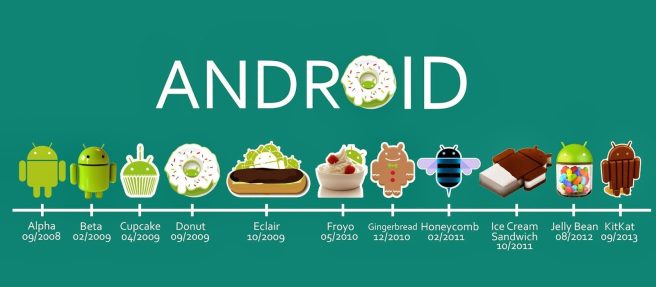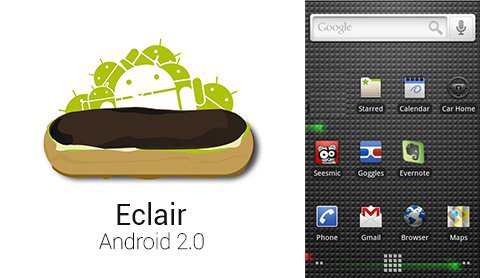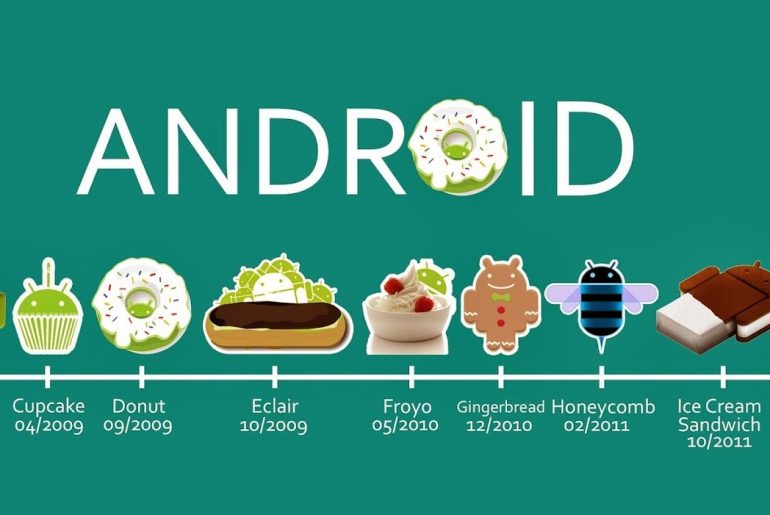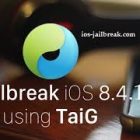It doesn’t seem long since the first version of the android debuted on the T-Mobile G1. Google’s Android underwent pretty drastic changes since the past six years or so. One can rightly say that no technology has underwent as quick and as drastic changes as the android operating systems powered by google.
With the recent announcement of the most-awaited Android “L”, we at Tenocation bring to you a brief history of various devices which were penetrated by the android operating system right since the beginning. Without any further ado, let us begin.
Android Version History

Dividing them by the versions in which they were released and upgraded as per their API history(Application programming interface), the features they brought with them as well as their release date, we begin with :-
Android 1.0
It was practically the first version released by the company. This software was released in september, 2008. For the first time, it was made commercially available to the wide consumer-base via. the HTC dream.
Features – Android Market, a web browser(with XHTML web pages, multiple pages shown as cards), Camera(although can’t change the resolution), access to web email servers, supporting POP3, IMAP4 and Simple mail transfer protocol). These features when first hit the market, were truly remarkable and garnered a large consumer base.
Additional features – GMAIL synchronization was definitely a big plus where as the Calendar and the contacts sync formed the fundamental base of this new version. Google Maps, Google Talk as well as an impressive bluetooth support were all welcomed.
Thus, the android 1.0 laid a strong foundation for the versions ahead.
Android 1.1 (API level 2)
Released in the month of february in 2009, this version was released initially exclusively for HTC dream. The android 1.1 resolved a lot of bugs and brought in fixes to the glitches in the previous version, namely Android 1.0.
More specifically, the android 1.1 brought with it many other features, namely :
- Longer in-call screen timeout when using the speakerphone
- Enabling the user to save attachments in messages
- Marquee support added in system’s layouts.
- Details on business available while MAP SEARCH.
Android 1.5 Cupcake (API level 3)
Then in the same year came the first version to officially use a code-name, ‘cupcake’. This was released in the month of April, 2009 and was based on Linux Kernel. The code-name was based on a dessert.
From here on, it was finalized that all the codenames to the forth-coming versions would be based on desserts. The additional features it integrated included :
- Third party virtual keyboards which also offered text prediction and user dictionary.
- There was an additional support for widgets, video recording and playback in MPEG-4 and 3GP formats.
- Copy paste features in the browser were enabled in this version for the first time. If you favorited a contact, you could view their picture.
- Animated screen transitions as well as uploading videos on youtube.
Android 1.6 Donut (API level 4)
Released in the same year as it’s predecessor, this version was based on the Linux kernel 2.6.29 and had many additional features :-
- Searches related to voice and text data entry were expanded to include contacts, history, web services.
- Multi-lingual speech synthesis engine support.
- Ability to view screenshots in the Android market.
- Tech support for CDMA/EVDO.
- Support for WVGA screen resolutions.
Android 2.0 Eclair (API level 5)

The additional features encompassed in this version of android included :
- Expanded account synchronization allowing users to add multiple accounts to a device for syncing.
- MS exchange email support as well as bluetooth 2.1 support.
- Ability to search all saved SMS cards, MMS messages in a conversation.
- Flash, digital zoom, scene mode, white balance and many more classy camera features.
- Refreshed browser UI with bookmark thumbnails and double tap zoom as well as support for HTML 5.
- Improved google maps with the newest version 3.1.2 as well as MotionEvent class to keep a track of multi-touch events.
Then there were various upgrades to this Eclair version namely 2.0.1 and 2.1 eclair which had pretty minor upgrades.
The next big installment in the android franchise was the —
Android 2.2 – 2.2.3 Froyo at API level 8
 Froyo, short for frozen yoghurt was the next version of the android operating system.
Froyo, short for frozen yoghurt was the next version of the android operating system.
- This one witnessed an increase in speed, memory as well as performance optimizations.
- Chrome V8 JavaScript engine was integrated into this OS.
- Support for android cloud to Device messaging(C2DM)
- Advanced launchers for applications. These also had shortcuts to phone and browser apps.
- Updated android market.
- Support for upload fields in the browser.
Android 2.3 – 2.3.2 Gingerbread (API level 9)
This benchmark version was released on 6th December, 2010 and was based on Linux kernel 2.6.35. The features supported by this version are numerous including : –

- A highly impressive UI with a simplistic design. Plus a native support for VoIP Internet telephony is a definite plus..
- Featured an enhanced copy/paste functionality, allowing users to select words by press-hold.
- Near Field Communication was introduced with this version.
- A completely new download manager, promoting easier file access.
- Improved power management as well as concurrent garbage collection for better performance.
Android 3.0 Honeycomb (API level 11)
Released on 22nd February, 2011 this SDK was the first tablet-only upgrade based on Linux kernel 2.6.36. Motorola Xoom tablet was the first device using this SDK. The features included :-
- A new holographic interface which promoted optimized tablet support.
- Added system bars and action bars.
- A redesigned keyboard making the typing fast and efficient.
- More intuitive interface for copying and pasting.
- New two-pane email UI which made viewing and organizing efficient.
API LEVEL 12 and 13 or honeycomb 3.1 and 3.2 – 3.6 had very similar features with very little upgrades.
Android 4.0 – 4.0.3 Ice Cream Sandwich (API level 14)
Based on Linux 3.0.1, this was released in October, 2011. This was the last version to officially support Adobe’s Flash Player. New features included :

- Many advancements in the “Holo” interface with new Roboto font family.
- Form Android 3.x, soft buttons are now available for use on phones.
- Separation of widgets in separate tabs.
- Improved voicemail features with features to speed up or slow down messages.
- Integrated screenshot capture as well as better voice recognition. Face unlock was a new feature too.
- Wi-Fi direct and 1080p video recording for stock android devices. Android VPN and TUN kernel module. Before this, the VPN required rooted android.
The succeeding updates included additional features which weren’t of much significance.
Android Jelly Bean 4.1-4.1.2 (API level 16)
 This was announced at the google I/O extended events at the conference IN 2012. This is based on Linux kernel 3.0.31 and this was a benchmark update.
This was announced at the google I/O extended events at the conference IN 2012. This is based on Linux kernel 3.0.31 and this was a benchmark update.
Project butter was behind this version which used touch anticipation and triple buffering as well as extended vsync timing to create a smooth UI. Thus, the features included :
- A smoother UI with Vsync timing as well as triple buffering.
- Bi-directional text and language support.
- User-installable maps.
- Expandable notifications.
- Ability to turn off notifications specific to applications.
- Bluetooth data transfer for android beam as well as a multichannel audio.
- FDK AAC codec became standard in android.
API levels 17 and 18 didn’t release much significant updates.
Android 4.4-4.4.4 KitKat (API level 19)
This version hit the android market in 2013. Initially, they had the code name Key Lime  Kie(“KLP”), the name was changed to kit-kat because very few people were aware of the real taste of key lime pie.
Kie(“KLP”), the name was changed to kit-kat because very few people were aware of the real taste of key lime pie.
This version debuted on Google’s nexus 5 and was then later released on a wide variety of devices. Improvements in this project were referred to as Project Svelte internally by google.
Minimum RAM requirement was 340 MB and all devices under 512MB were reported as low RAM devices.
The new features include :
- The clock doesn’t shows bold hours, all digits became thin.
- Applications could trigger translucency in the context of navigation bars and status bars.
- Immersive mode to be used by these applications to keep the bars hidden while interacting.
- Restriction for applications while accessing external storage, except while accessing their own directories.
- Optimized to performed on lower-end devices. Also embedded in them was the NFC host card which performed emulation, enabling device to replace smart cards.
- Webviews solely based on Chromium engine.
- There was a public API for managing text messaging clients. In addition, there was sensor batching, step detectors and counter APIs integrated in the system.
The subsequent updates were merely bug fixes or glitch-fixes.
Android 5.0 – 5.0.2 Lollipop (API level 21)

This was released with the codename “Android L” in 2014 during Google I/O. It was distributed as OTA, over-the-air updates for selected devices which ran on services by google, namely, nexus and google play edition devices.
Featuring a materialistic design and a responsive language, this is the kind of phone one must really wish to have. Android Runtime officially replaced Dalvik for improved app. performance, this was referred to as Project Volta.
- Android Runtime (ART) with ahead-of-time compilation with an improved garbage collection which replaced Dalvik.
- Support for 64 bit CPUS.
- Had an OpenGL ES 3.1 environment and an extension pack on GPU configurations.
- A refreshing looking screen with no longer support for widgets supported by project volta for battery life.
- Lock screen which gave shortcuts to apps and notifications. Guest logins and multiple user accounts were also included.
- Audio input through USB devices as well as audio output. Third party apps were again given the access to read and modify data.
- Addition of 15 new languages such as Bengali, Basque, Chinese and many more included. Tap and go allows user to quickly shift to a new android device using NFC and BT to transfer google acc. details.
This was a downright history of the android operating system. As google announces the next, android Marshmallow, all eyes are set on how they deliver the upcoming version.

Stay tuned for more updates!





1 Comment
good and I appreciate this issue. Its a great pleasure reading your post. I’d really like to help appreciate it with the efforts you get with writing this post. You have some real writing talent. Thank you.